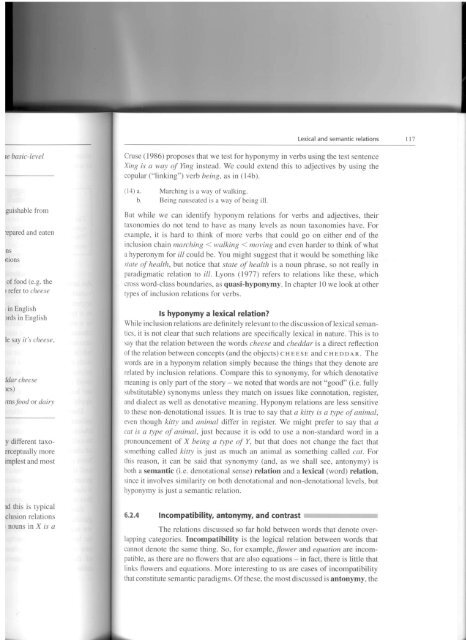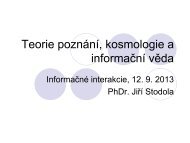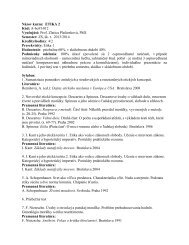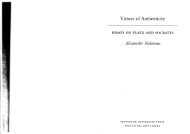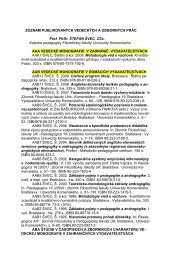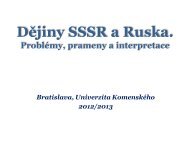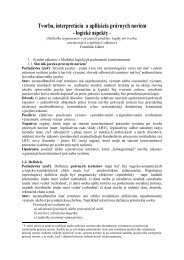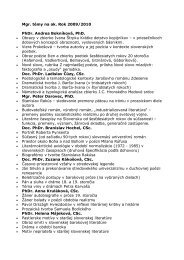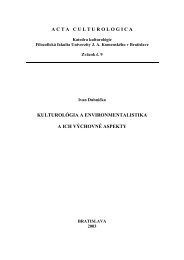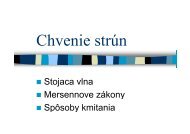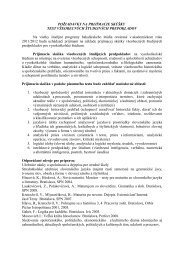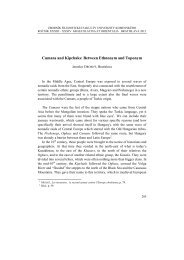Create successful ePaper yourself
Turn your PDF publications into a flip-book with our unique Google optimized e-Paper software.
le basic-level<br />
guishable from<br />
.epared <strong>and</strong> eaten<br />
of food (e.g. the<br />
) refer to cheese<br />
.in English<br />
ord in English<br />
le say it 's cheese,<br />
idar cheese<br />
les)<br />
rmsfood or dairy<br />
y different taxoereeptually<br />
more<br />
imple t <strong>and</strong> most<br />
Id thi i typical<br />
eiu ion <strong>relations</strong><br />
: noun in X is a<br />
Lexical <strong>and</strong> <strong>semantie</strong> <strong>relations</strong> 117<br />
Cruse (1986) proposes that we test for hyponymy in verbs using the test sentence<br />
Xing is a way of Ying instead. We could extend thi to adjectives by using the<br />
copular ("linking") verb being, as in (14b).<br />
(14) a. Marching is a way of walking.<br />
b. Being nauseated is a way of being ill.<br />
But while we can identify hyponyrn <strong>relations</strong> for verbs <strong>and</strong> adjective , their<br />
taxonornie do not tend to have as many level as noun taxonomies have. For<br />
example, it is hard to think of more verbs that could go on either end of the<br />
inelusion chain marching < walking < moving <strong>and</strong> even harder to think of what<br />
a hyperonyrn for iII could be. You might sugge t that it would be something like<br />
state of health, but notice that state of health is a noun phrase, so not really in<br />
paradigrnatic relation to iII. Lyon (1977) refers to <strong>relations</strong> like these, which<br />
cross word-class boundaries, as quasi-hyponymy. In chapter 10 we look at other<br />
types of inclusion <strong>relations</strong> for verbs.<br />
Is hyponymy a <strong>lexical</strong> relation?<br />
While inelu ion <strong>relations</strong> are definitely relevant to the discussion of <strong>lexical</strong> semantics,<br />
it i not clear that such <strong>relations</strong> are specifieally <strong>lexical</strong> in nature. This is to<br />
say that the relation between the word s cheese <strong>and</strong> cheddar i a direct reflection<br />
of the relation between concepts (<strong>and</strong> the objeets) CHE ESE <strong>and</strong> CH EDDA R. The<br />
words are in a hyponym relation imply because the things that they denote are<br />
related by inclu ion <strong>relations</strong>. Cornpare thi to ynonyrny, for which denotative<br />
meaning i only part of the story - we noted that word are not "good' (i.e. fully<br />
ubstitutable) synonyrn unless they rnatch on is ue like con notation, register,<br />
<strong>and</strong> dialect as well as denotative meaning. Hyponyrn relation are le s sensitive<br />
to these non-denotational is ue . It i true to ay that a kitty is a type of animal,<br />
even though kitty <strong>and</strong> animal differ in register. We might prefer to ay that a<br />
cat is a type of animal, ju t because it is odd to u e a non-st<strong>and</strong>ard word in a<br />
pronouncernent of X being a type of Y, but that doe not change the fact that<br />
something cali ed ki/ty is just as much an animal as sornething cali ed cat. For<br />
this rea on, it can be said that synonymy (<strong>and</strong>, as we shall see, antonyrny) is<br />
both a semantic (i.e, denotational en se) relation <strong>and</strong> a <strong>lexical</strong> (word) relation,<br />
sinee it involve imilarity on both denotational <strong>and</strong> non-denotational levels, but<br />
hyponymy is just a ernantic relation.<br />
6.2.4 Incompatibility, antonymy, <strong>and</strong> contrast<br />
The <strong>relations</strong> di eu sed so far hold between words that denote overlapping<br />
categorie . Incompatibility is the logical relation between words that<br />
cannot denote the same thing. So, for example, fiower <strong>and</strong> equation are incompatible,<br />
as there are no flowers that are al o equation - in fact, there is little that<br />
links flowers <strong>and</strong> equations. More interesting to us are cases of incornpatibility<br />
that con titute sernantic paradigrns. Of these, the most di cussed iantonymy, the


